Whether you are hunched over a laptop in a makeshift workspace or slouched on the couch binge-watching TV, you know – and can feel – that sitting for long periods can sabotage your health.
From head to toe, these simple exercises can provide relief, restore muscle function and improve posture.
1) For strained eyes
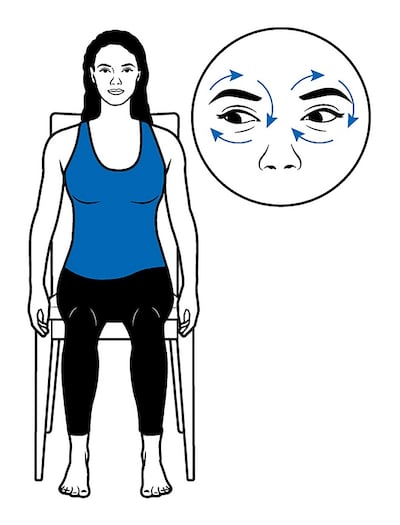
Too much screen time can result in headaches, blurred vision and itchy eyes. To alleviate strain and strengthen your eyes, try eye rolls.
Sit up straight and look down to your right, roll your eyes toward the sky, then to the left and down back to the ground. Then roll your eyes in the opposite direction.
Repeat five times.
2) For sore a neck and tense shoulders
Typing on a computer or tapping on a phone – whether standing or sitting – draws our focus and our head forward as we look down. As that happens, the upper trapezius muscle and neck lengthen and tense, and the muscles in the front of our body contract and shorten. Over time, that causes tension in the neck, shoulders and upper back.
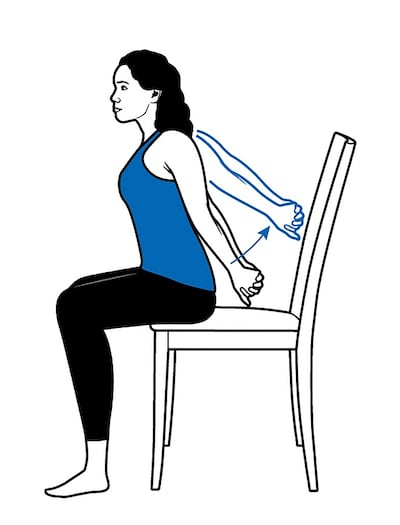
This self-massage technique immediately releases neck tension: start by looking over each shoulder and noticing where your gaze lands. Now, start the stretch on the right side by dropping your right ear to your right shoulder. Take two fingers to the top of your neck behind your left ear and find the sternocleidomastoid muscle, the little valley that runs down your neck. Gently walk your fingers down this muscle, palpitating as you go. Repeat on the other side. Now look over your shoulders again and notice how far you can see. You can do this stretch standing or sitting.
For another seated stretch to help you open your shoulders, release tight chest muscles and combat poor posture, scoot to the edge of your chair or stool, extend your arms behind your back and interlace your fingers. Try to keep the palms together and actively roll your shoulders back and puff up your chest. To deepen the stretch, start to lift your clasped hands. Hold the stretch for up to a minute.
3) For a tight back

A seated cat-cow yoga flow, which arches the spine forward then rounds it back, can open the chest, take pressure off the spine and stretch the back. Sit at the edge of your chair with both feet flat on the floor. Rest your palms on your knees. As you inhale, press the chest forward.
As you exhale, tuck your chin to your chest and round the spine forward. Repeat three to five times, following your breath.
In the same seated position, you can do side bends and twists to release the compression between the vertebrae and increase your range of motion. First, inhale and sweep your arms overhead. Hold your left wrist with your right hand, keep your arms by your ears, exhale and bend toward the right.
Hold the stretch for five breaths, inhale to centre, switch your hands, exhale and bend to the left. Hold for five breaths. Inhale back to centre, release the grip on your hands, exhale and twist to the right, letting your hands fall to the outside of your thigh or chair.
Hold for five breaths, inhale to centre and repeat to the left.
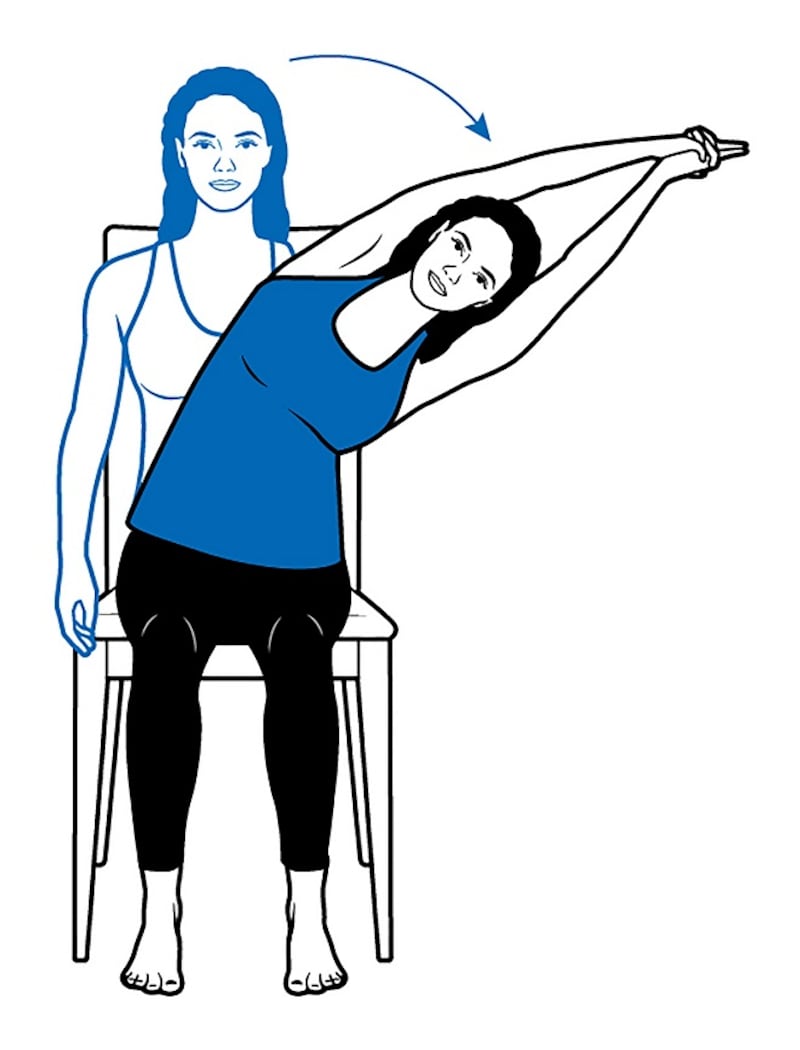
4) To restore the lower back, hamstrings and calves
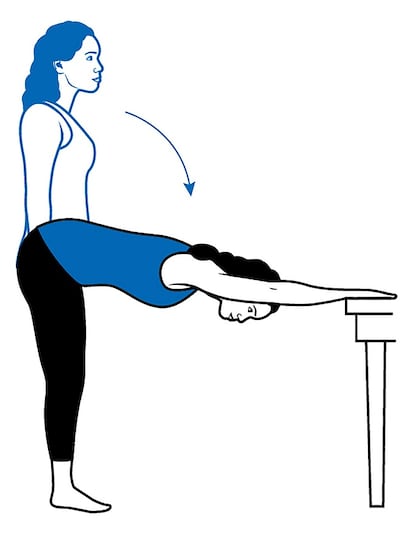
When we sit for long periods, the lower spine contracts and the posterior muscles in our legs, particularly the hamstrings, shorten. A modified yoga down-dog pose using your desk or kitchen table will stretch the entire back of your body. Start by standing, with your chair out of the way, and place your palms flat on your desk.
Walk backward until your arms are extended and your body is in an L shape with your feet under your hips. Press your hands into the table, elongate your back and push your hips up and back. Hold for five to 10 breaths.
5) Strengthen glutes and hamstrings
Sitting for hours also shortens and tightens the hip flexors. The butt muscles compensate by lengthening, which can lead to dead butt syndrome, where the glutes weaken and struggle to keep the body in proper alignment. You can strengthen your glutes and hamstrings with a bridge-march stretch.
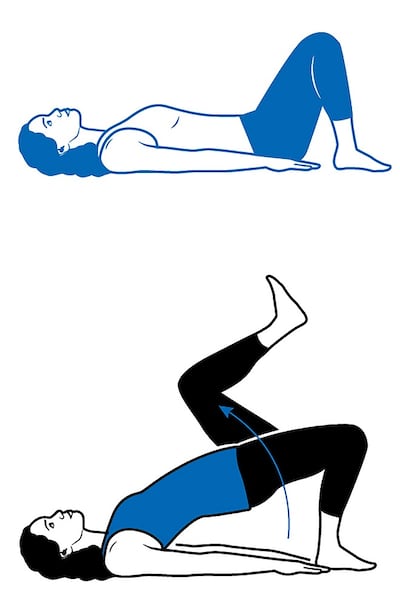
Begin by lying on your back, with your knees bent and your arms by your side. Your feet should be hip-width apart and 10 to 12in from your butt. Squeeze your glutes and lift your hips up into a bridge position. Hold here while you lift your right foot off the ground, bringing your knee towards your chest until your hip is at a 90-degree angle. Lower your right foot to the ground and repeat on the left.
Repeat 10 times, both your left and right feet, keeping the hips lifted throughout. A runner’s lunge can help lengthen and stretch your hip flexors. From a standing forward fold, bend your knees, take both hands to the floor and step your right foot back. Drop the right knee and slide the foot back, lowering your pelvis until you feel a gentle stretch through the front of your thigh. Stay here with your hands framing your foot, or inhale and lift your torso up. Hold for five to 10 breaths and repeat on the other leg.
6) And don’t forget your feet

When you massage the bottoms of your feet, you start to loosen connective tissue that runs up the back of your body, including in the calves and hamstrings. To see how quickly this works, sit on the floor with your legs extended and feet flexed. Exhale, fold forward with a flat back and walk your fingers forward alongside your legs, as far as you can go. Notice the point where your hands land. Now, forget about your hands but stay on the floor and place a tennis ball or something similar under the ball of your foot.
Put as much weight on it as you can tolerate and roll the ball back and forth the length of your foot several times. Repeat with the other foot. When you’ve finished, repeat that forward fold. Where are your hands now? – The New York Times








